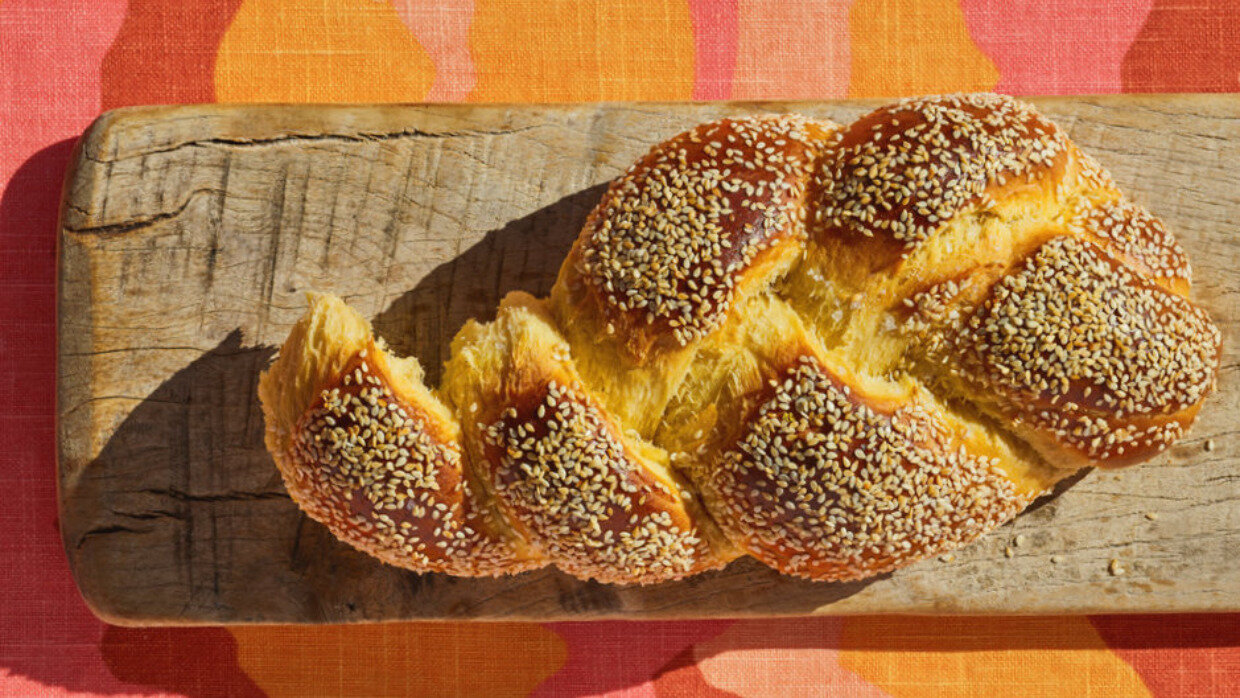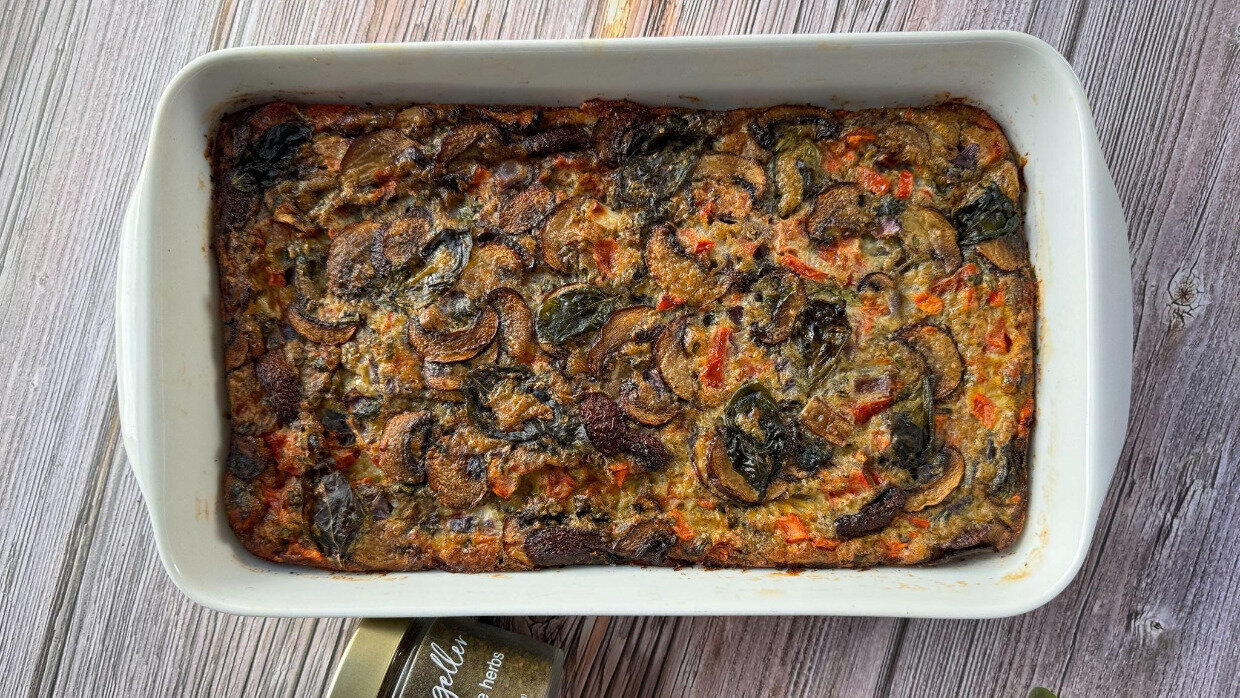If there is one recipe that defines Shabbat, it’s challah, and my table isn’t complete until a pair of loaves sit on the table. The wonderful challah recipe from Sababa contains olive oil and honey, and while it has made regular bakers out of many of you, I wanted this one to be even simpler, using vegetable oil and plain white sugar instead of olive oil and honey. I also add a tiny pinch of turmeric, which gives the challah the most gorgeous golden hue without imparting any
flavor. The key to the challah’s perfect crumb is allowing plenty of rising time, both before and after braiding. I am a devotee of a simple three-strand plait; Instagram was practically created for incredible eight-strand artworks, but the simple, meditative back-and-forth of a three-strand braid means you’ll be able to do this one with your eyes closed. My recipe recommends kneading by hand after pulling the initial dough together in a stand mixer, but if you want to machine-knead, by all means use the mixer to do so.
Two Challahs on the Table
According to the biblical story, while the Jewish people were in the desert, attempting to travel from Egypt to Israel, they were hungry. To feed them, God sent down manna from heaven (aha—now we know where that phrase comes from!), and it took on the taste of whatever it was the Jews wanted to eat. During the week, they each received one piece of manna, but before Shabbat they received two, so they wouldn’t have to work by gathering their meal. Today, we place two loaves of challah on the table for Shabbat meals to symbolize those two pre-Shabbat portions of manna.
Ingredients
- 3/4 cup 177 grams/ml warm water (110° to 115°F, a little hotter than you think), plus up to 1/4 cup (60 grams/ml) more
- 1/2 cup 100 grams plus 2 tablespoons (24 grams) sugar
- Two 1/4-ounce 7-gram packets active dry yeast (41/2 teaspoons/14 grams total)
- 1/2 cup 110 grams/ml vegetable oil, plus 1/2 tablespoon (7 grams/ml) for greasing the bowl
- 1/8 teaspoon ground turmeric
- 4 large eggs
- 6 cups 780 grams all‑purpose flour, plus more as needed
- 2 1/2 teaspoons 14 grams fine sea salt
- 1/2 cup 70 grams sesame seeds
- Flaky sea salt such as Maldon, or kosher salt
Nutritional Facts
Instructions
- In the bowl of a stand mixer, whisk the warm water and the 2 tablespoons (24 grams) sugar(I use a fork—no need to dirty the whisk). Whisk in the yeast and let it get foamy and fluffy for 5 to 6 minutes (if this doesn’t happen, your yeast is dead! Start over!). Whisk in the remaining 1/2 cup (100 grams) sugar, 1/2 cup (110 grams/ml) of the oil, the turmeric, and 3 of the eggs until incorporated.
- Add the flour and fine sea salt, then fit the mixer with the dough hook to incorporate the ingredients well and mix on medium speed, stopping the mixer and using a silicone spatula to coax any loose flour into the dough, until the dough is shaggy but unified, 3 minutes. If the dough does not hold its shape at all and looks more like a wet blob, add more flour, 1/4 cup at a time, to achieve the desired texture; if the dough feels dry and crumbly, add up to 1/4 cup more water. If you wish to knead in the mixer, continue to knead on medium speed until the dough is smooth and plush without being sticky and pulls away from the mixer without leaving any dough on the sides or bottom of the bowl, 5 to 6 minutes (the dough may seem ready earlier, but kneading this long helps develop the gluten, which will make for a stronger, better dough with better crumb and structure).Transfer to a very lightly floured work surface (if you have a marble countertop, I recommend starting without flour and only adding it if the dough feels impossibly sticky in an all-over-your-hands way).
- Using the heel of one hand to lean into the dough and the other to rotate it, knead until a very smooth dough forms, another 9 to 10 minutes. If you get tired, rest for a second, throw some dishes in the sink, then keep kneading for another minute or two. You should be able to hold the ball of dough and not have it stick to your hands, but it also shouldn’t feel too dry or tear across the top; you’re looking for smooth!
- Add the remaining 1/2 tablespoon oil to a large metal bowl and use a pastry brush or your hands to coat the bowl with the oil. Add the dough, flip it to coat lightly in oil, seal with plastic wrap, then cover with a clean kitchen towel and let the dough sit in a warm place until at least doubled but ideally tripled in size, 1 hour 30 minutes to 2 hours for double and 3 hours for triple (tripling makes the dough lighter, so if you have time, I recommend it). Uncover the dough and punch it down with your fist, then transfer the dough from the bowl to the work surface.
- Cut the dough into 2 equal-sized pieces (or 3 for smaller challahs), then cut each larger piece into 3 smaller pieces.
- Line a large baking sheet with parchment paper. Press down on each piece of dough to release any air bubbles, roll each into a 12-inch log (or a 10-inch log if you are making 3 challahs), then roll out and taper the ends of each log to form 16-inch logs (or 12-inch logs for 3 challahs). Let the logs rest for 5 minutes to allow the gluten to relax. Pinch the top ends together, pressing down the pinched top with a chef’s knife to secure the dough. Braid the logs, forming a challah that is slightly tapered on both ends and plump and generous as it reaches the center. Tuck the ends under and arrange the loaves on the parchment-lined sheet, leaving at least 4 inches between loaves. Let rise, covered, in a warm, draft-free place, until the challahs puff and nearly double in volume, 1 hour.
- During the last 15 minutes of rising, set a rack in the center of the oven and preheat the oven to 350°F.
- Beat the remaining egg in a small bowl, then brush the challahs thoroughly all over with the egg, making sure not to neglect the sides of the challah all the way down to the parchment (so that the sesame seeds will coat the whole challah). Coat each challah with 1/4 cup of the sesame seeds (or about 2 1/2 tablespoons if you’re making 3 challahs). Sprinkle with the flaky sea salt and bake until the challahs are golden and fluffy and the undersides are a lovely golden brown color and sound hollow when tapped, 34 to 36 minutes for 2 large loaves, 28 to 30 minutes for 3 medium loaves.* Cool and slice.
Notes
Recipe courtesy of Shabbat: Recipes and Rituals from My Table to Yours by Adeena Sussman. Photo credit: Dan Perez















